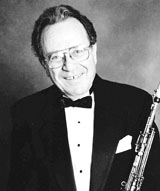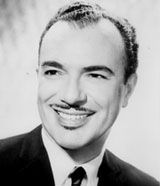Allegro
Requiem
Volume CIX, No. 10October, 2009
RAY BECKENSTEIN

|
Ray Beckenstein, 86, a multi-reed player and an 802 member since 1941, died on Aug. 24.
Mr. Beckenstein was a highly respected and successful doubler, playing all the saxophones, clarinet, flute and piccolo in many hit Broadway shows. He was an in-demand freelancer and recorded with such artists as Barbra Streisand, Paul McCartney, Paul Simon and Frank Sinatra.
Mr. Beckenstein first went on the road with Johnny McGee’s band, and went on to play with Artie Shaw. Later big band gigs included playing for Bobby Sherwood, Bob Chester, Benny Goodman, Orrin Tucker, George Paxton and Shep Fields.
Eventually, Mr. Beckenstein landed a steady five-year engagement at the Latin Quarter nightclub in New York. He began his Broadway career in 1955, in a show called “Vamp,” starring Carol Channing.
Much of his professional time and passion were devoted to his almost 40-year involvement with the New York Saxophone Quartet, which he co-founded, along with Danny Bank, in 1959. The soprano player of the group, Mr. Beckenstein was regarded by his peers as especially gifted, and distinguished himself by receiving the Naras Award for “Soprano Saxophone Player Of The Year” in 1984 and 1986. Many jazz and new music composers, such as Phil Woods, George Handy, Manny Albam, Gene DiNovi, Don Hammond, Eugene Orloff and John Carisi created works for the quartet that survive today as established pieces in the saxophone repertoire.
Mr. Beckenstein and his wife, Ruth, were married in 1947. She survives him, along with his two daughters, Cara and Marion, and two sisters, Sylvia and Harriet.
EDDIE LOCKE
Eddie Locke, 79, the jazz drummer, died on Sept. 7. He had joined Local 802 in 1956.
Mr. Locke was associated with the Detroit jazz scene in the 1940’s and 1950’s, playing from 1948 to 1953 with drummer Oliver Jackson in a variety show called Bop & Locke. He moved to New York City in 1954, and worked there with Dick Wellstood, Tony Parenti, Red Allen, Willie “The Lion” Smith, Teddy Wilson, Roy Eldridge, and Coleman Hawkins.
In the 1970’s, Mr. Locke played with Lee Konitz, Tiny Grimes, and Earle Warren in addition to remaining in Eldridge’s band at Jimmy Ryan’s through the end of the 1970’s.
Mr. Locke appeared in the famous photograph “A Great Day in Harlem.” Art Kane, a freelance photographer working for Esquire magazine, took the picture around 10 a.m. in the summer of 1958. The musicians had gathered on 126th Street, between Fifth and Madison Avenues in Harlem.
He is survived his sons Edward and Jeffrey, grandsons Jeffersen Carver and Gunnar Livingston, and his companion Mary Ellen Healy.
Obituary from Wikipedia
BOBBY PRING

|
Bobby Pring, 84, a trombonist and a Local 802 member since 1977, died on July 8.
The following is an excerpt from an essay about Mr. Pring that the late Leo Ball wrote in Allegro in 2005. The full interview can be read at www.tinyurl.com/BobbyPring.
“If there’s any one phrase that captures the playing of trombonist Bobby Pring, it is ‘smooth as satin.’ The epiphany that determined his musical direction occurred prior to World War II when Mr. Pring heard the Jack Jenny recording of ‘Stardust’ for the first time. He recalls, to this day, saying to himself, ‘That’s the way I want to sound!’
“In 1943, Mr. Pring was drafted into the Air Force, and stationed as a band member at Greensboro, North Carolina, where he stayed until discharge in 1946. He immediately accepted the jazz chair on the Tony Pastor band, and the next few years traveled with many of the name bands of the day, finally ending up joining Les Brown in 1950. In 1956, he accepted the house band gig at Hollywood’s famous Moulin Rouge.
“He shortly became one of the busiest freelance players on the Los Angeles scene, doing movie soundtracks, all kinds of studio work, and accepting short stints with the best bands of the day. He played with Benny Goodman, Bob Crosby, Charlie Barnet, Bob Florence, the Commanders and David Rose. Also, he fronted his own organization for a number of years.
“He migrated to New York in 1977, and, besides working steady Sundays with trumpeter Max Kaminsky at Jimmy Ryan’s, also did many weekday subs for trombonist Bobby Pratt with the house band fronted by the incredible Roy Eldridge. In a short time, he was in demand as a club dater for many of the major New York offices.”
GEORGE RUSSELL
George Russell, 86, the music theorist, composer, conductor, educator, drummer and pianist, died on July 27. He had been a Local 802 member since 1956.
Mr. Russell’s groundbreaking 1953 book, “The Lydian Chromatic Concept of Tonal Organization,” proposed the concept of playing based on scales rather than chords. His ideas influenced the development of modal jazz.
He received a MacArthur Foundation genius grant in 1989. In his career, Mr. Russell also received the NEA American Jazz Master Award, two Guggenheim Fellowships and the British Jazz Award, among others.
It is impossible to sum up Mr. Russell’s influence and importance in this short space. Interested readers should see www.George
Russell.com for much more.
He is survived by his wife
Alice, son Jock and three grandchildren.
WE ALSO REMEMBER . . .
Carlton Camarata, trombone
John Porrazzo, guitar
Abraham Ringle, violin
Ken Somerville, trumpet
Abe Torchinsky, tuba
To report a death of a member, contact Theresa Couture at (212) 245-4802, ext. 115 or Tcouture@Local802afm.org.
